By now, you’ve probably heard me talk about Pinterest Traffic Avalanche (also sometimes referred to as Pinterest Organic Traffic Avalanche–the name must’ve changed at some point).
I purchased this online course earlier this year in an attempt to break through a traffic plateau I was experiencing.
In this Pinterest Traffic Avalanche review, you’ll find out what I loved about this course and where I think there’s room for improvement so you can make an informed decision about whether or not this Pinterest course is worth the cost for YOU.
It’s the only Pinterest course I’ve ever spent money on and I know a lot of you, like me, are frustrated with the results you’re getting from Pinterest and want to know if you should throw down the $197 to learn Alex and Lauren’s secrets.
I’m going to get to all of that down below, but first, who the heck are these people and why should you trust them to take your Pinterest success to the next level?
Pinterest Traffic Avalanche Review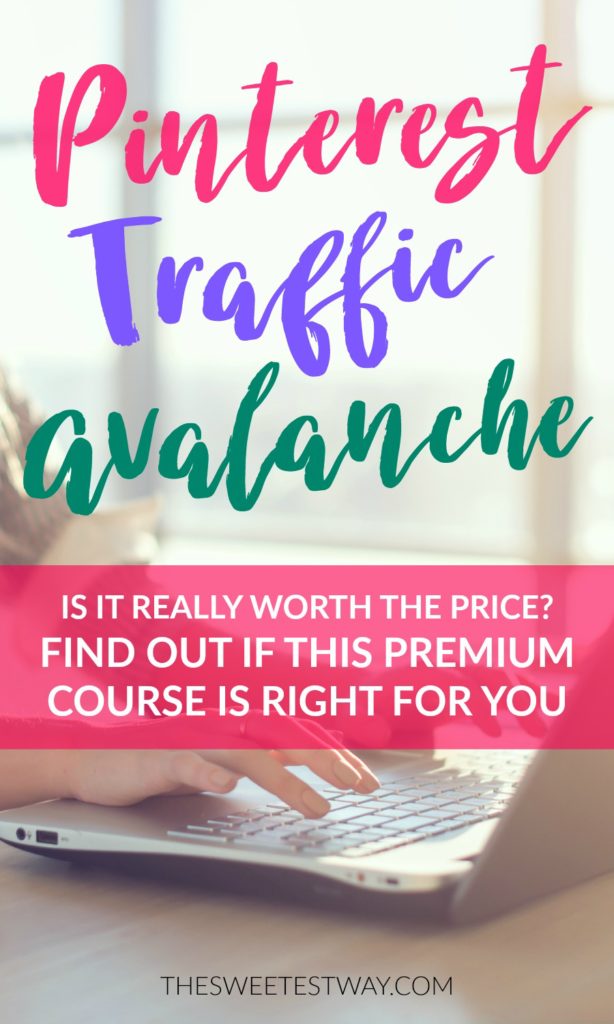
Please note: This post contains affiliate links, meaning I may earn a commission if you make a purchase, at no extra cost to you. Thank you for supporting The Sweetest Way!
Pinterest Traffic Avalanche: Is This #Pinterest Course Worth the Cost? #blogging #makemoneyonline Click To Tweet
Meet Your Gurus: Alex and Lauren of Avocadu, Creators of Pinterest Traffic Avalanche
To be honest with you, I can’t quite remember how I stumbled upon this particular Pinterest e-course, but there’s a good chance that it happened not-so-ironically on–you guessed it–Pinterest (collective gasp!).
So, Alex and Lauren, the power couple behind Pinterest Traffic Avalanche, managed to get me on their email list and paying them nearly two hundred dollars through their use of Pinterest, if that’s any indicator of their expertise.
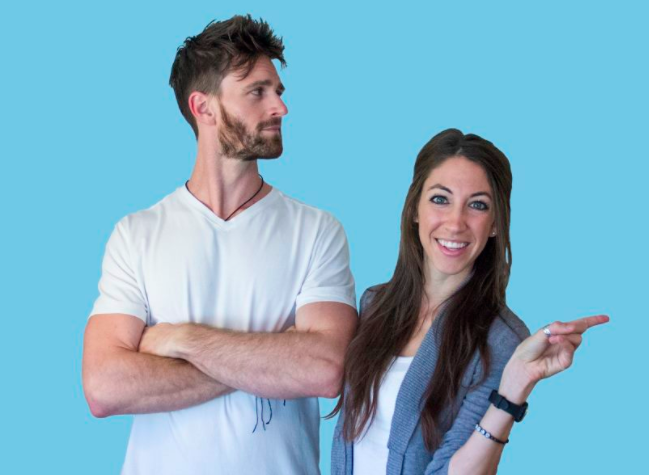
But how did they get started, you ask?
Well, Alex and Lauren are two fitness experts and former 9 to 5ers who realized starting a website would free them from their corporate shackles and give them the freedom they desired.
They now run online businesses including the fitness site Avocadu as well as a second site called Create and Go that’s dedicated to helping bloggers like you and me make a full-time living.
They’re knowledgeable, they’re personable, they’re total go-getters, and they didn’t become successful by blogging about blogging.
They built a thriving fitness website that generates income through the sale of physical products (like supplements) digital products (like fitness e-books–the Yoga Fat Loss Bible is one of their biggest sellers), affiliate marketing and ads.
Pretty standard stuff, really, but on a scale that most bloggers are still dreaming of–to put that into concrete terms, in their first year of running Avocadu, they pulled in $103,458. Six figures in their first year of blogging!
They’re very forthcoming about the fact that Pinterest played an ENORMOUS role in Avocadu’s success and because their strategies proved so powerful, they wanted to share that knowledge with other bloggers. Their stats ARE impressive, there’s no denying that…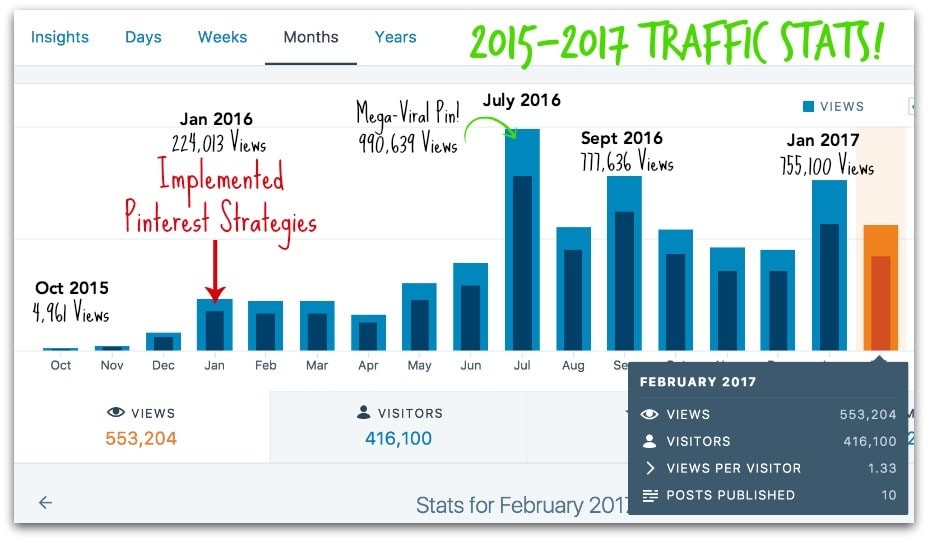
Create and Go is where they discuss how they’ve monetized Avocadu and again, they’re very generous and transparent about their strategies.
I don’t know about you, but I tend to gravitate toward bloggers and content creators who believe in and practice an abundance mindset–the ones who realize that there’s enough prosperity to go around and therefore there’s no reason to withhold valuable information if it can help someone else succeed.
Course Layout
Pinterest Traffic Avalanche is hosted on Teachable, an e-learning platform that I personally love. It’s clean and uncluttered, easy to navigate, and makes the learning process stress-free and even enjoyable. It lets you easily track your progress in the course, and you can seamlessly move back and forth between lessons by clicking the buttons at the top of your screen.
On the left-hand side of the screen will be your list of lectures. This particular course kicks off with some administrative stuff such as how to join their private support group on Facebook and downloadable tools such as a spreadsheet for planning your pinning strategy and checklists that allow you to follow their tactics step by step. For visual learners who love taking notes, these printable resources will come in very handy.
The next section is where the video lessons begin. Here are all the individual sections and chapters you’ll find in this course:
- Tools and Downloads
- Private Support Group
- Pin Schedule Planner
- Pinterest Beginner Checklist
- Viral Pin Checklist
- Follower Tracker Spreadsheet
- Our Favorite Resources
- Introduction to the Program
- Welcome to Pinterest Traffic Avalanche!
- Your Focus Strategy
- Updates and Algorithm Changes
- Introduction to Updates
- New Features Being Tested
- New Pin Metrics
- Laying the Foundation to Pinterest Success
- Pinterest Demographics, Tips, and Guidance
- Successful “Guy-Focused” Brands on Pinterest
- Broad Brand Focus with Subtopics
- Beginning With the End in Mind
- Getting Started and Setting Up Your Account for Success
- Setting Up Your Account for Success
- Applying for Rich Pins
- Pinterest SEO 101 – What is SEO?
- Pinterest SEO 201
- Designing Your Profile and Boards
- Creating Viral Content on Pinterest
- What Makes Pins Stand Out
- Creating Curiosity to Increase Clicks to Your Website
- Tips for Creating New Pins
- Creating Viral Topics and Headlines
- Creating Stunning Pins Using Canva
- How to Avoid Pinterest Jail
- The Power of Group Boards
- The Importance of Group Boards
- Finding and Joining Group Boards
- When to Leave Group Boards
- Automating Your Pinterest Traffic
- Pinning Strategies
- Overview of Scheduling Pins
- How to Schedule Pins Using Tailwind
- How to Use the Excel Pin Schedule Planner
- Social Warfare Plugin
- Promoting Pins
- The Basics of Promoting Pins
- How to Create a Promoted Pin
- Analytics and Tracking Progress
- Pinterest Analytics
- Tools to Track Website Stats
- Tailwind Analytics
- Overview of Boardbooster
- Pinterest Ninja Secrets
- Ninja Secret #1: Pain Before Gain
- Ninja Secret #2: Shotgun Theory
- Ninja Secret #3: Email Collection Secrets & Strategies
- Ninja Secret #4: Stop Pinning Other People’s Content
- BONUS – Six-Figure Blogger Content
- The Strategy Behind a Six-Figure Blogging Business
- Light Monetization: Sponsored Posts and Ads
- Affiliate Marketing vs. Creating Your Own Products
What I Love About Pinterest Traffic Avalanche
Alex and Lauren are likable and approachable teachers.
Their videos are fun to watch and they explain things in very simple terms that anyone can understand. In their Facebook group, Lauren is very active and always willing to answer students’ questions.
You don’t feel as though these are celebrity bloggers looking down on us plebs, but as though they are our peers who just happen to have a vested interest in helping us succeed.
The course is thorough and regularly updated.
This course covers everything a new Pinterest user needs to know and then some, and it’s being updated all the time.
In fact, as I was revisiting the content in order to write this review, I discovered new videos that have been added since I initially signed up for the course a few months ago. This shows Alex and Lauren’s dedication to making this an evergreen resource that people can continue using as Pinterest changes and grows as a platform.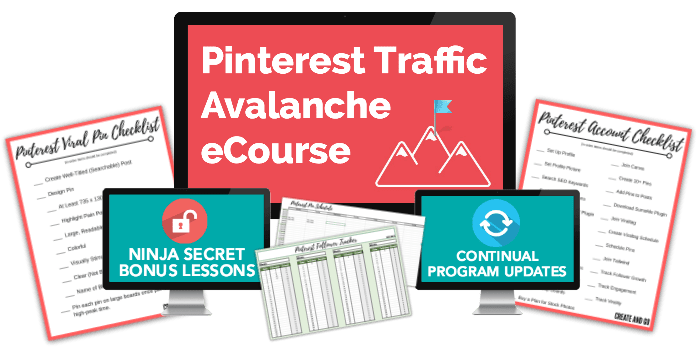
As with all other social mediums, Pinterest’s algorithms change frequently, and it can be frustrating trying to keep up with it all and modifying your strategy as you go. Lucky for those of us in this course, these guys take it upon themselves to stay on top of updates and to share that knowledge with us. And while we’re on the topic…
They’re not afraid of algorithm changes.
Perhaps one of the things I appreciate the most about Alex and Lauren’s teaching style is that they face changes to Pinterest head-on. Instead of whining about the latest updates, they immediately try to figure out how to best evolve with these updates instead of clinging to their old way of doing things.
They understand that Pinterest has good intentions with each of these new updates and that their purpose is to provide a better overall user experience. Platforms like Pinterest and Facebook and Instagram are going to evolve whether we like it or not, and it’s simply not worth wasting time resisting this evolution and pining for the way things used to be.
Room For Improvement
Some of their suggestions do not feel attainable for solo bloggers.
Alex and Lauren blog as a team–that must be amazing to have someone else at the helm, helping brainstorm and create new content. Quite frankly, I’m jealous.
This has obvious advantages, like being able to produce tons of new content each week. In one of their videos, Lauren mentions that putting out content at a fast clip (we’re talking 4-5 times per week) has been extremely valuable to their Pinterest strategy.
As a solo blogger, I’m already feeling enormous pressure to just get TWO new posts published per week, and here they are attributing much of their success to publishing new posts nearly every other day. That’s a result that I simply cannot replicate unless I want to put out content with not a lot of depth or hire someone to write for my blog.
Their niche matters more than they let on.
It’s not hard to see why fitness and weight loss is such a popular topic on Pinterest. People are always looking to get in better shape, lose weight, eat healthier, and so on (women especially, and Pinterest users are about 80% women). This is a DAILY need that Alex and Lauren are fulfilling on a massive scale.
Travel, on the other hand, is something people dream about and plan for only once in awhile. Only 36% of US citizens even have passports! Travel isn’t a part of your daily life unless you’re a digital nomad, and we’re still a tiny minority when compared to the population at large.
For this reason, I worry that I’ll never see Pinterest success on the same scale as Avocadu, because even though travel is certainly growing in popularity, it’s still the most famous destinations that get the most love–think Paris, New York, London, and Bali–and travel doesn’t hold a candle to fitness and weight loss.
A quick search on Pinterest will reveal that the most viral of all travel pins might get repinned 60K times, but a quick search for fitness pins tells a very different story: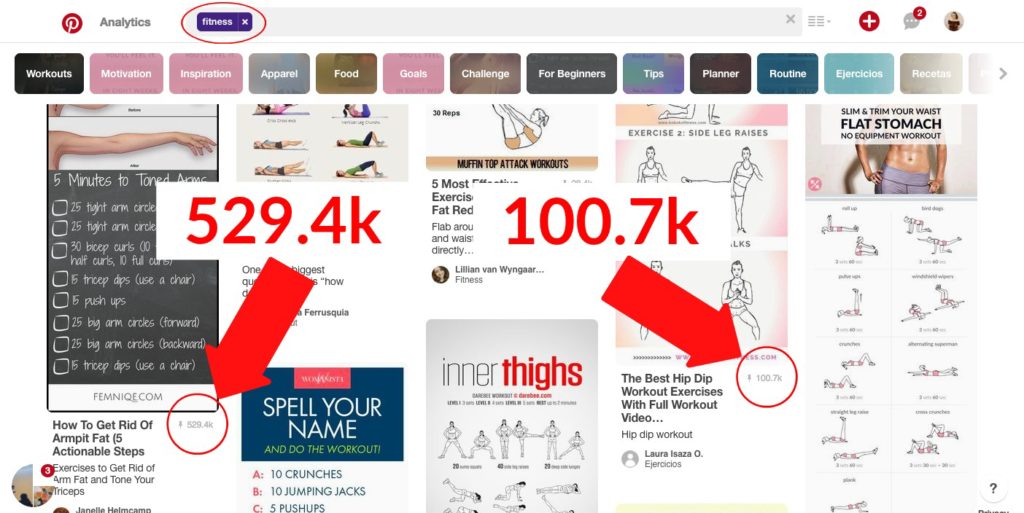
With so much interest in fitness and healthy eating, there is huge potential for viral Pinterest content within this niche.
I could try my hand at writing roundup-style posts and listicles about the “10 Best” or “10 Cheapest” or “10 Safest” destinations, but if you’ve been reading my blog for any length of time, you know that’s not exactly my style. I don’t think it adds value to people’s lives, and it won’t help me stand out from the millions of other blogs people could choose to read.
Lauren and Alex have also admitted that because of the popularity of their niche, they have chosen not to pursue SEO as a source of site traffic–they didn’t think they could compete with existing fitness blogs from an SEO standpoint. This means their posts are often on the shorter side, right around the 1,000-word mark.
I don’t see this as a smart long-term strategy for my niche–I believe in the power of Google and I plan to harness it–so while I could put out several 1,000-word posts each week, I’d rather pour my energy into creating in-depth content that stands a chance of bringing me sustained Google traffic.
Now, the popularity of their niche isn’t exactly something they have any control over and it doesn’t mean their suggestions don’t work–it just means that some of their strategies won’t apply to other blogging niches and so it’s important not to expect the same results, no matter how closely you replicate their methods.
My Results
I purchased Pinterest Traffic Avalanche in late March of 2017 and completed the modules within a few weeks. Much of the information was stuff that I already knew–after all, I’ve been working as a Pinterest account manager and consultant for the last two years, so Pinterest isn’t exactly foreign to me.
But, I’d been seeing my Pinterest traffic steadily decline after hitting a high note in January–I’d gone from 1,200 referrals per day to less than 1,000 per day in a very short time, and I wanted to know what pieces of the puzzle I was missing.
At that point, I should also mention I’d been using Boardbooster as my pin scheduling tool for about 5 months. I’d stumbled upon Rosemarie Groner’s Boardbooster tutorials and figured I’d give it a shot, and things were going really well for awhile. I joined a ton of new group boards, I had my secret boards all set up, and I had pins looping on my most successful boards.
Then suddenly, things weren’t going so great. Pinterest was updating its algorithms at a furious pace–it looked different every time I logged in–and I became more and more frustrated as time went on.
Buying Pinterest Traffic Avalanche was sort of a Hail Mary to save what felt like a sinking ship.
So, was it the saving grace I was hoping for? Not quite.
I wish I could tell you that my Pinterest traffic skyrocketed after applying what I learned in this course, but that’s not the reality.
At the very least, though, my traffic did level off and was no longer declining as it had been from January to March and I do attribute that to the methods I put into practice after completing the course. As of right now, Pinterest remains my #1 traffic source, sending me 600-800 referrals per day.
Here are a few reasons things might have turned out this way:
- I already knew a lot of what the course teaches, so there weren’t many new strategies for me to try – They did help me fill in a few holes and their Ninja Secrets were indeed powerful, but like I said, I’ve been at this for some time now and a lot of the info was stuff I’d read elsewhere or already tried myself. This would be a different story for a new blogger or someone building a Pinterest account from scratch.
- I was never able to blog at the same rate they were – I typically publish 2 new posts each week–I do want to increase that to 3 per week, and I’m curious to see how that affects my Pinterest traffic given how much they attribute their success to publishing new content.
- I’m nowhere near as diligent as Lauren when it comes to tracking analytics – Lauren is a former accountant who loves numbers and analyzing data, so her spreadsheets were a bit over my head. Perhaps if I’d been able to track my progress as carefully as she did, I’d have found more opportunities for adjusting my strategy.
- My blog features a lot of personal posts which typically don’t perform well on Pinterest – Avocadu is all about fitness and healthy eating, and every post makes sure to answer “What’s in it for me?” for the reader. Strictly factual or informational posts tend to bore me as a writer–I like to mix it up by writing about what I’m feeling, and that doesn’t really jive with Pinterest. Users want a question answered, they’re not really looking for inspirational posts.
What I’m trying to say here is that there were a lot of factors that led some of these strategies to fall flat for me, on top of the fact that I didn’t even come close to replicating them exactly.
I don’t fault this course for my lack of growth on Pinterest–I fault myself. And let me be absolutely clear, here: I don’t regret purchasing this course in the slightest.
Now that I’m blogging full-time, I have every intention of revisiting the content and putting more of their suggestions to use, tweaking and testing everything from my pin design to my style of content. On the other hand, I’m not putting all my eggs in the Pinterest basket, and I recommend the same to other bloggers.
Of course, it’s not all bad news–Pinterest Traffic Avalanche came at a time when I needed new inspiration, and it gave me some real gems to work with.
Here are a few of the best things I took from this course:
- Knowing when to leave group boards – I used to follow the advice of many other so-called Pinterest “experts” who believe that group boards are the be-all-end-all of Pinterest strategy and that you should join as many as you possibly can. Lauren flipped this idea on its head and gave me plenty of good reasons to do the exact opposite, and most notably, she taught me how to know when to leave group boards that are no longer worth my time.
- How Pinterest SEO is different from Google SEO – The course contains two sections on “Pinterest SEO,” because Pinterest really is more like a search engine than a social media platform. People don’t come to Pinterest to make connections with other users, they come to Pinterest to find solutions to their problems. But the tactics for optimizing a pin are different from how you’d optimize a post for Google, and they break it all down for you.
- Beginning with the end in mind – This is one of the ways Lauren and Alex decide what content to create, and it’s a pretty smart strategy that I’ve never seen elsewhere. It’s all about making sure that, before you start writing, your blog post has a purpose and a goal that you want the reader to achieve. They call this “sales-centered content” and it’s this strategy that allowed them to monetize Avocadu rather than simply driving traffic for the sake of traffic.
- My return to Tailwind – After using Boardbooster and seeing less-than-stellar results, it was Lauren herself who convinced me to go back to Tailwind as my preferred pin scheduler. Her detailed overview of how to put Tailwind’s analytics to work, plus a reminder that Tailwind is Pinterest’s ONLY approved API partner, persuaded me to give it another try and I have been very happy with that decision.
- Sometimes it’s worth it to pay for stock images – This course helped me get over myself and realize that if I wanted to create some really professional, eye-catching pins, I’d have to pony up a bit of cash. I’ve found some amazing images on Shutterstock that suited my needs perfectly and I would never have made that leap without the encouragement.
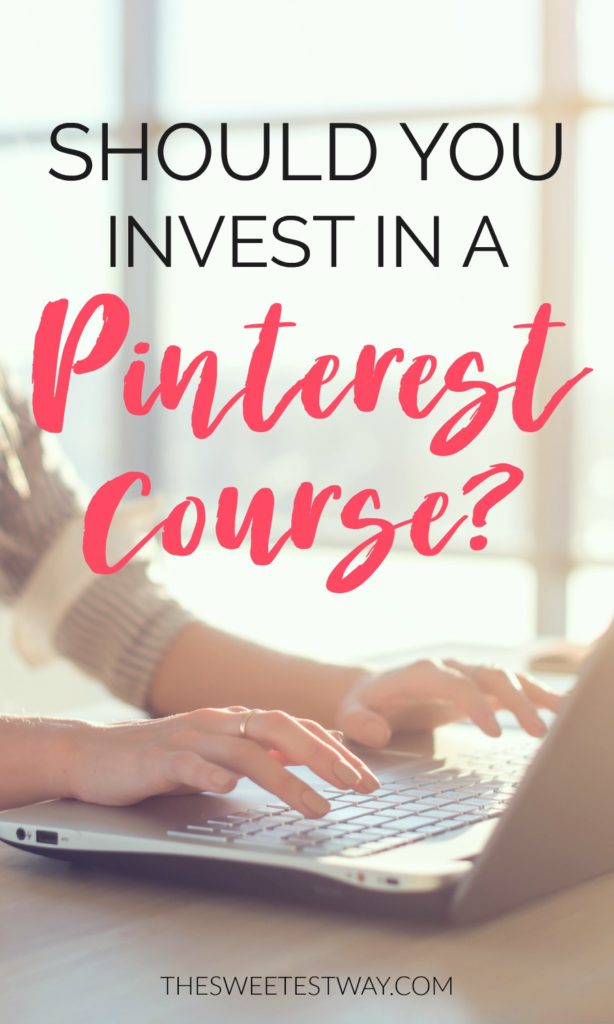 Is Pinterest Traffic Avalanche Worth the Cost?
Is Pinterest Traffic Avalanche Worth the Cost?
For someone who is relatively new to using Pinterest for business, I strongly believe Pinterest Traffic Avalanche is worth every last penny.
Here’s why:
- It covers all of the foundational knowledge you need to set your Pinterest account up for success right from the very beginning. And because it’s updated so regularly, I’m confident this will be the only Pinterest resource you’ll need.
- They explain everything in great detail–most video lessons are 10 to 20 minutes in length. You really get the sense that they’re leaving out nothing, leaving no stone unturned.
- It’s focused on not just using Pinterest to drive traffic, but using Pinterest to generate sales and revenue for your website.
- They share secrets that you won’t find in any other Pinterest course–their “Ninja Secrets” at the end of the course are tips I’ve never seen before and are probably worth the course’s purchase price all on their own.
If you’re starting from zero, this course will definitely help you build a solid foundation and start to see some real growth on Pinterest. It will also save you tons of time you would otherwise spend scouring the web trying to find all of this information for free.
If you’re already pretty experienced with Pinterest, this course may not suddenly take you to viral Pinterest success, but that doesn’t mean it won’t fill the gaps in your knowledge or give you new ideas for your strategy.
And then again, maybe you will find that missing puzzle piece that allows you to create a viral pin or generate thousands of dollars in sales.
“Always walk through life as if you have something new to learn and you will.” -Vernon Howard
Plus, their regular updates to the course material when Pinterest changes their algorithms are powerful resources to have access to. I know I can stay informed of changes through the private Facebook group or new video lessons as they are added, which means less work on my part.
I don’t believe there’s such a thing as a “true expert” on any topic, so I know that if I want to continue to see growth on Pinterest, I will have to continue learning and improving every single day.
Investing in courses like this is one of the best ways I can do that, and I’d recommend the same mindset to anybody.
Have taken Pinterest Traffic Avalanche? Do you think it’s worth the price?



